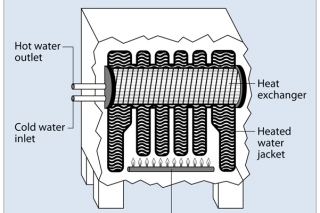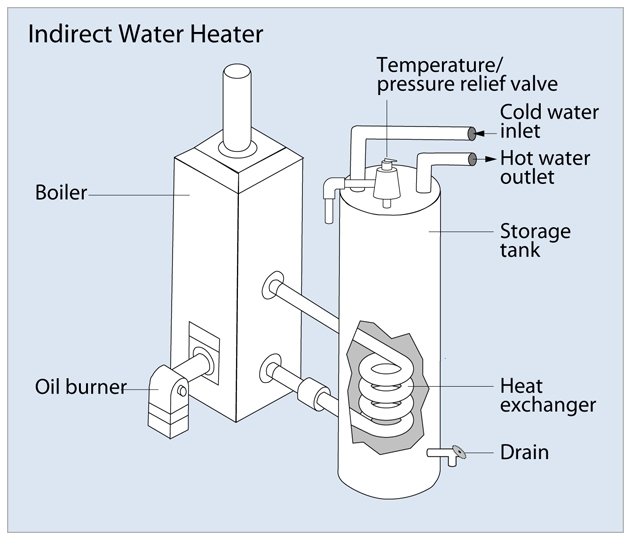How Does a Boiler Work? A New York Tech Explains
September 26, 2017
How a boiler works really depends on the kind of boiler you have.
But the primary purpose of all boilers is to transfer heat to water. Basically, boilers work by heating water or producing steam that is then used to heat a home.
But, of course, that’s a barebones explanation of how boilers work. The inner workings of a boiler gets more complicated once you start looking at the different kinds of boilers.
We’ll explain how different kinds of boilers operate. But first, let’s take a closer look at the operation process that all boilers share.
Have boiler problems and need a professional’s help? Just contact us. We’ll send over a tech right away.
The boiler process
- Your home’s thermostat senses a drop in your home’s temperature and calls for the boiler to turn on.
- Your boiler powers on and uses either oil, gas or electricity to create heat.
- The heat from the fuel source is used to heat up water inside the boiler.
- The heated water or steam is sent throughout your home (via radiators or radiant floor systems) where it gives off its heat to warm the air.
- As the water cools (or the steam condenses), it travels back to your boiler where it’s reheated and sent back out to continue heating your home.
- This process continues until your home reaches the set temperature and your thermostat calls for the boiler to turn off.
Now that you know the general boiler process, let’s look at the different kinds of boilers and how they operate slightly different from each other.
The different types of boilers
Boilers are classified according to a lot of different factors, including their:
Pressure and temperature
Fuel type
Form of heating (hot water vs steam)
Heating method (firetube vs watertube)
Draft method
Size/capacity
Ability to provide heat only vs. heat and hot water
Efficiency (whether it can recover wasted heat or not)
But for simplicity’s sake we’ll take a look at the most common classifications: fuel type, form of heating and the boiler’s ability to provide heat only vs heat and hot water.
Fuel type
As we mentioned above, a boiler has to first create heat (during what’s called the “combustion process”) before it can transfer heat to water. But different boilers use different fuel sources to create that heat.
To create heat, a boiler uses one of 3 different fuel sources:
Gas
Oil
Electricity
Gas boilers
When it receives the call for heat from your thermostat, a gas boiler uses either a pilot light or an electric start to ignite gas and oxygen inside a “combustion chamber”. The combustion chamber is a safe, secured chamber where the gas is burned to produce heat. That burning gas heats up the “heat exchanger”—a web of copper piping that transfers its heat to water.
Gas boilers are the most common form of boilers and are usually cheaper to install and operate than oil boilers.
Oil boilers
Oil boilers perform the same way as gas boilers: oil burns inside the combustion chamber and heats up the heat exchanger, which in turn heats water.
However, the main difference between oil and gas boilers is that an oil boiler requires an oil storage tank. The oil must be delivered to the home and stored in the tank until it’s needed. Oil boilers aren’t as eco-friendly as gas burners but they can sometimes be more efficient, depending on the model.
While oil and gas prices fluctuate, oil boilers are generally more expensive to operate than gas boilers.
Electric boilers
Electric boilers are generally used in homes where natural gas is not available. An electric boiler creates heat in a slightly different way than their oil or gas counterparts. Instead of burning fuel, they use electrical power to heat elements. Those hot elements then transfer heat directly to water.
While electric boilers burn “cleaner”, they’re not as efficient and are more expensive to operate than oil or gas boilers.
Form of heating
Gas, oil and electric boilers can heat your home in one of 2 ways:
Hot water
Steam
Hot water boilers don’t actually “boil” water. They heat water to 140-180 degrees Fahrenheit. An electrical pump is needed to push that hot water throughout the home.
Steam boilers, on the other hand, heat water past the boiling point to produce steam. The steam is then distributed throughout the home via radiators or radiant floor systems.
Since it takes more energy to boil water than to simply heat it, steam boilers are usually less efficient. However, heating water to steam increases the pressure inside the system, which means steam boilers don’t require the additional energy uptake of a circulating pump.
Heat only boilers vs combi/system boilers
While traditional boilers are designed to only provide central heating, some boilers are designed to also function as a hot water heater.
Boilers that are designed to provide heating and hot water are either:
Tankless coil systems
Indirect systems
Tankless coil systems use the boiler’s heat exchanger to heat water on demand. That means, any time you turn on a hot water faucet, water will run over that hot heat exchanger, heat up and be delivered to you.
This water heating method is super efficient in the winter months since it’s “piggybacking” off of the heat created by the boiler to warm your home. On the other hand, it becomes an “energy guzzler” during the warm summer months because the boiler isn’t being used for heat anymore but is still forced to turn on anytime hot water is needed.

Indirect systems also use the heat exchanger to heat water but the hot water is stored in a tank. The water is kept hot in the storage tank and only used when it’s needed. This is usually a more efficient form of water heating because it doesn’t require the boiler to turn on and off every time you need hot water.

Still have questions about how your boiler works? Ask a NYC tech
If you live in the NYC metro area and need boiler advice or have boiler issues, we can help.
Just call us or schedule an appointment online. We'll send a tech right over!
